The Birkenau Camp
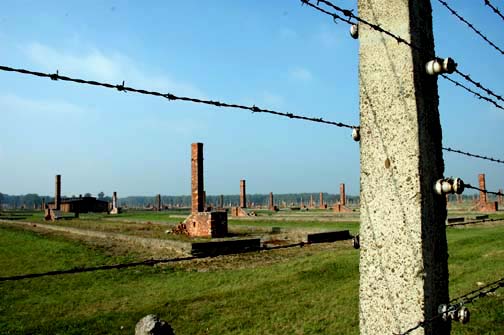
Electrically charged
barbed wire fence around Birkenau camp
The Birkenau camp was opened on October
7, 1941 when the first transport of Soviet Prisoners of War,
captured during the German invasion of the Soviet Union, arrived.
From October 1941 to February 1942, there were 13,775 POWs brought
to Birkenau. Only 92 of them were still alive when the last roll
call was taken on January 17, 1945.
Beginning in February 1942, the Birkenau
camp became an extermination camp for Jews. The camp covers 425
acres and it had 300 buildings before it was abandoned in January
1945. Today there are 45 brick buildings and 22 wooden buildings
still standing at Birkenau.
In the photo above, you can see the remains
of the stoves in the barracks buildings that were either burned,
or torn down, when the camp was abandoned on January 18, 1945.
In the background on the left is one wooden barrack building
still standing in a vast field of chimneys.
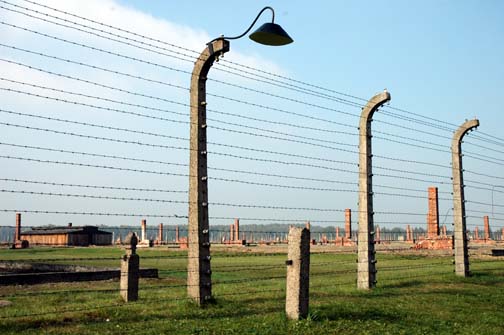
The camp was lit by
electric lamps at night
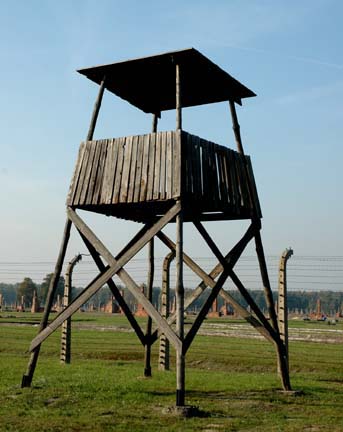 Guard Tower along the
main road through the camp
Guard Tower along the
main road through the camp
The photo above shows a flimsy wooden
guard tower. Notice that there is no ladder. There are several
of these guard towers, which were added later; they do not show
in the photographs taken by the Germans on May 26, 1944.
 Close-up of the ruins
of a brick barracks stove
Close-up of the ruins
of a brick barracks stove
The Birkenau camp was divided into sections;
each section was surrounded by a barbed wire fence. One section
was the Gypsy Family camp where 20,946 men, women and children
lived together and did not have to work. According to Rudolf
Höss, the Commandant of Auschwitz-Birkenau, there were only
4,000 of them left in August 1944 and they were taken on trucks
to the gas chamber in Krema V on August 2, 1944 when the Gypsy
camp was liquidated.
After the Gypsy camp was liquidated,
it was used to house the Hungarian Jews who were brought to Birkenau.
Elie Wiesel, the famous author of the book "Night,"
was deported to Auschwitz-Birkenau in May 1944 on one of the
first transports of Hungarian Jews. According to Wiesel's account
in his book, the Kapos in charge of the barracks where he stayed
were Gypsies.
The photo below shows an interior barbed
wire fence around the men's camp, which is in section BIId to
the left of the road. The Gypsy camp was in section BIIe, adjacent
to the men's camp on the west side.
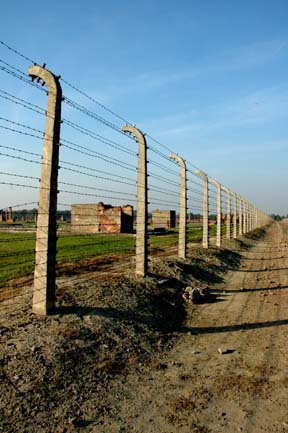 Fence surrounds the
former men's camp at Birkenau
Fence surrounds the
former men's camp at Birkenau
The road on the right in the photo above
is an interior road, which runs north and south, at the midway
point in the camp. This road starts in the women's camp and extends
to the new section called Mexico, which was never finished. The
camp was intended to hold 250,000 prisoners when construction
was completed.
The photo below shows the same road,
which, according to the display there, was a short cut from the
selection ramp to the gas chambers in Krema IV and Krema V, located
on the north side of the camp. Across the road from the Krema
IV building was the Central Sauna where incoming prisoners were
registered and processed, beginning in 1943. The prisoners who
were gassed immediately upon arrival were not registered.
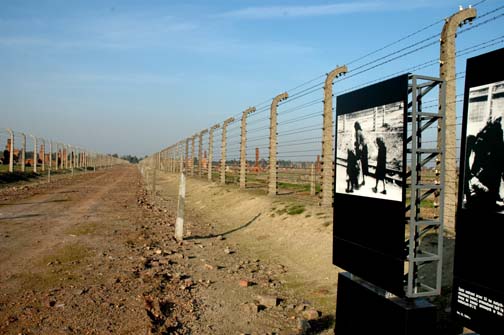 Camp road was a shortcut
to gas chambers IV and V
Camp road was a shortcut
to gas chambers IV and V
A display board beside the road shows
the famous photo of a woman and her children walking to the gas
chamber.
Elie Wiesel, the famous author of "Night,"
walked with his father along this route after their arrival on
a transport train inside the camp in May 1944. It was on this
road that Wiesel saw two burning pits, one for children and one
for adults. Wiesel witnessed children being thrown alive into
the burning pit. Wiesel and his father were spared at the last
moment when, only two steps from the burning ditch, they were
ordered to turn left and enter the barracks on the west side
of this road.
The following quote is from "Night"
by Elie Wiesel:
Not far from us, flames were leaping
up from a ditch, gigantic flames. They were burning something.
A lorry drew up at the pit and delivered its load-little children.
Babies! Around us, everyone was weeping. Someone began to recite
the Kaddish. I do not know if it has ever happened before, in
the long history of the Jews, that people have ever recited the
prayer for the dead for themselves .... Never shall I forget
that night, the first night in camp .... Never shall I forget
that smoke. Never shall I forget the little faces of the children,
whose bodies I saw turned into wreaths of smoke beneath a silent
sky.
This page was last updated on June 2,
2009
|